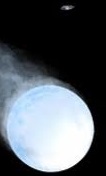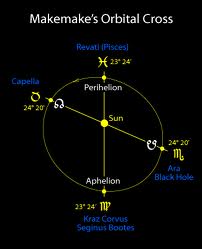

Of all the recently discovered Dwarf Planets, this was the one that really got me wondering what the astronomers were on when they named it. Generally, an object gets named in one of two ways: One– a descriptive name. Take a black hole for instance, it’s black and… well…it’s a hole in space time. Or how about a pulsar? A pulsating star. Or my personal favourite, the Big Bang, no description required!
The other method of naming is after mythology, and this is mostly seen when it comes to planets and moons within the solar system. Mars is the god of war; Venus is the goddess of love; Pluto and Charon are from the underworld; then there is Mercury, Jupiter, Saturn… You get the idea.
Considering this, seeing the name “Makemake” as the newly discovered Dwarf Planet boggled my mind as to where the name came from. However, as we shall soon see, its not quite as strange as you might think. This dwarf planet was first discovered just after Easter in March 2005 and was originally known as 2005 FY9, a very uninteresting name. Yet, due to it being discovered just several days after Easter, it was given the pet name of the” Easter Bunny.”
So what is the connection between the Easter Bunny and Makemake? Well, following with the theme of gods and such, Makemake is the creator of humanity and the god of fertility to the natives of Easter Island. To us westerners “Makemake” isn’t pronounced the way that we would traditionally say it, it’s not Make-make but pronounced Mah-kay Mah-kay. When saying it out aloud I feel like I’m talking about a fish but that’s just me 🙂

So a little more about this dwarf planet, it has only been in fairly recent times that we’ve actually been able to get any real information on this dwarf planet. On April 23rd 2011 a very special event happened that allowed us to infer some information on this icy dwarf planet–it passed in front of a faint star! This event only lasted for about a minute, so a lot of information had to be gathered very quickly. 7 telescopes were pointed at Makemake as it made its transit in front of NOMAD 1181-0235723. These 7 telescopes were both ground and space based, some were optical and others infrared and of various sizes, the more information collected the better!
What did we learn? Makemake is sort of round, a sphere slightly flattened at both poles with dimensions of 1502×1430 km (approximate), an average density of 1.7 grams per cubic centimeter and an albedo of 0.77. To put this into terms that we all might find easier to understand: It’s about 2/3 of the size of Pluto, a little less dense than Pluto, and more reflective than Pluto. Makemake’s surface is composed of what would be best described as “Dirty Ice”, like Eris more than Pluto in this regard.

Another very interesting thing to note is that Makemake has no atmosphere, at least nothing at all detectable. As Makemake passed in front of NOMAD 1181-0235723 the light falloff was instant as opposed to a gradual decline, this tells us that there was no atmosphere dimming before the icy sphere blocked out the light. Will Makemake have an atmosphere? Well it might, when it hits its perihelion it may be close enough to the sun so as to “melt” the surface converting it into a gas and forming a temporary atmosphere. This is what happens on Pluto. Makemake’s orbit has it as close as 38.5 AU but as far out as 53 AU. To compare this with Pluto, it has orbital parameters of 29.7 and 48.7 respectively. So Makemake has an eccentric orbit…but not quite as much as Pluto has.
Well there we have it, Makemake is a dwarf planet made of dirty ice that is a little smaller than Pluto, at a further orbit, and not quite round. It’s named after the creator and a god of fertility as believed by the natives of Easter Island and was discovered just days after Easter in 2005. Personally, I still think that Mah-kay Mah-kay sounds like a fish.